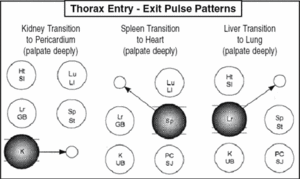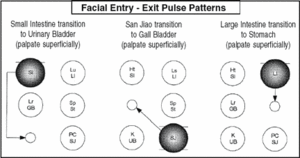Whether you accept it, avoid it or live somewhere in between, insurance coverage has become a defining issue for our profession. Patients increasingly expect to use their benefits, practitioners want to be compensated fairly for their time and expertise, and the system itself remains – at best – fragmented. The encouraging news is that coverage has expanded in meaningful ways. The challenging news is that reimbursement, across the board, remains inadequate.
The Ying Qi Cycle
Editor's note: This article is from an upcoming book, Neoclassical Pulse Diagnosis. It is the result of clinical application of classical passages.
"When one is joyous, then the qi is in harmony and the mind is unimpeded. The nutritive qi and the protective qi pass freely," states Qi Bo in The Yellow Emperor's Classic. So also, when the nutritive and the protective pass freely, then joy can arrive.
This article examines a method of diagnosing and treating the flow of the nutritive qi that is commonly used in Europe and America. It continues the neoclassical method of pulse diagnosis that is a "whole system" view of the Five Phases, and the nutrient, defensive and essence forms of qi. As with all aspects of this system, the findings are verified clinically.
Ying Qi
Ying qi is translated as "construction qi" by Wiseman2 and "camp qi" by Unschuld.1 The definitions of nutrient qi and protective qi find root in military metaphors and could be likened to the U.S. Department of the Interior vs. the U.S. Department of Defense. In this article, I translate ying qi as "nutrient qi" to reflect clinical usage. Nutrient qi is the essence of water and grain: When it is harmoniously balanced in the five zang and dispersed through the six fu, it can enter the vessels. It is an aspect of blood that travels through the primary vessels providing nourishment.
The circulation of ying qi takes place throughout the day, remaining approximately two hours in each vessel. This movement corresponds to the tracking of the sun across the sky. For example, the sun at midday corresponds to the ying qi moving in the Heart vessel; at sunset, the ying qi moves within the Pericardium vessel. This process correlation - the apparent motion of the sun in the sky and the ying qi in vessels - demonstrates the importance the ancients placed on the relationship of the inner world with the outer world and the significant emphasis placed on this set of correspondences.
The two fire radicals in the upper portion of the character ying suggest not only a campfire, but also the fire of the sun, with the line below suggesting a rooftop. As Walt Whitman once said, "Give me the splendid silent sun with all his beams full dazzling." The lower portion of the character suggests an encampment.
Therapeutic Implications of Nutrient Qi Flow
The Spiritual Axis states that if all pulse qualities are even, the patient will recover. This statement has also been conveyed by one of my teachers, John H.F. Shen. When patients have even pulses by the end of treatment, they often report the effects of treatment lasting longer or acting more deeply. Ying qi and wei qi imbalances are discussed in reference to causing impediment diseases or bi syndromes. Qi Bo states in chapter 43 on bi syndromes:3
The nutritive qi is the essential qi of water and grains. It harmonizes the five zang organs, spreads in the six fu organs, and then can enter the channels. Therefore the nutritive qi runs up and down along the channels, penetrates the five viscera and links the six fu bowels. The protective energy is the intrepid qi of water and grains. It is intrepid, swift and slippery in property, but it cannot enter the channels. Therefore, the protective qi runs within the skin and the muscles, steams the membranes, and spreads in the chest and the abdomen. If the nutritive qi and the protective qi become disordered, diseases will occur; if they are not disordered, the illness will be cured, and the wind cold, and damp will not assail, so impediment will not ensue.
Furthermore, chapter 31 of the Su Wen1 states:
When the three yin and yang vessels and the viscera and bowels have all received disease then the nutrient and defensive qi no longer move, the qi cannot pass through the viscera - death results.
For a discussion on the flow of wei qi and its diagnosis, see my previous articles on Acupuncture Today.4-6
Detecting an Entry/Exit Block on the Pulse
The key to pulse diagnosis of the entry-exit (E/E) system is the two-depth system of the Nan Jing and the Mai Jing. This method places the yin vessel deep and the yang vessel superficial (see Figure 1).

The pulse of the channel where the obstruction is taking place will be inflated, larger, fuller or more forceful7 than the subsequent channel along the circuit of the flow of ying qi. The pulse that represents vessel ying qi content after the entry-exit blockage tends to be weak, feeble, or even absent. The most common stagnation of ying qi occurs between the Spleen and Heart vessels from Sp 21 to Ht 1; it also occurs between Liver and Lung at Lv 14 to Lu 1.
It should be noted that the evaluation of the ying cycle is only possible through the two-depth system of the Nan Jing and Mai Jing, wherein the right chi position is san jiao superficial and Pericardium deep.
Causes of Blocks
Physical injury to a region may result in an entry-exit block, particularly if scarring is involved, which restricts the flow of qi. A channel injured by a surgical scar, for instance, may often show signs of either a local excess or deficiency. In a relatively strong person, traumatic injury will often generate inflated qualities on the pulse that correspond to the organ or region injured. These qualities indicate either trapped qi, heat, or blood. A weaker individual may exhibit a flat quality on the pulse after the same injury. An appropriate strategy, in either case, may be to treat the entry-exit points before and/or after the affected channel, according to the pulse.
Internal causes of entry-exit blocks include constitutional predisposition, the seven affectations and lifestyle. This could be due to intense emotional experiences that impede the smooth flow of qi along the vessels. Another example is an individual sitting at a desk for extended periods of time for over 15 to 20 years. This can cause the qi to bind in the middle burner and not distribute freely into the upper burner, and could involve impediment of the qi movement from the Liver to the Lung, or from the Spleen to the Heart. The processes may appear as qi depression-stagnation; blood stasis dampness and heat dampness or food accumulation.
Entry-Exit Principles
- Entry-exit blocks are more likely to occur between elements, rather than within the same element.
- Interelemental blocks in the head are among the yang channels.
- Interelemental blocks on the chest are among the yin channels.
The Organ Clock - Ying Cycle
| Table #1: The organ clock and the entry-exit points of the 12 channels. | |
| Sequence of entry point-exit point qi circulation | Time |
| Ht 1 - Ht 9 | 11 a.m. - 1 p.m. |
| SI 1 - SI 19 | 1 p.m. - 3 p.m. |
| UB 1 - Bl 67 | 3 p.m. - 5 p.m. |
| KI 1 - Ki 22 | 5 p.m. - 7 p.m. |
| PC 1 - PC 8 | 7 p.m. - 9 p.m. |
| SJ 1 - SJ 22 | 9 p.m. - 11 p.m. |
| GB 1 - GB 41 | 11 p.m. - 1 a.m. |
| Li 1 - Li 14 | 1 a.m. - 3 a.m. |
| Lu 1 - Lu 7 | 3 a.m. - 5 a.m. |
| LI 4 - LI 20 | 5 a.m. - 7 a.m. |
| St 1 - St 42 | 7 a.m. - 9 a.m. |
| Sp 1 - Sp 21 | 9 a.m. - 11 a.m. |
Case Study
Sam came to my office originally for Lyme's disease in 1991. The successful management of his condition with acupuncture and herbs led to a clinical relationship lasting 12 years for the management of occasional sports-related injuries. More recently, Sam had difficulties with depression and unemployment; he regularly made business decisions that interfered with his ability to make a decent living in his profession.

Upon taking his pulse, I discovered that the left Kidney position (left proximal or chi) was full, and the right Pericardium position (right proximal or chi) was weak. This could be interpreted as an entry-exit block between the kidney and pericardium. The focus of the treatment was Ki 22 and PC 1. According to the organ clock system, this is the time of sunset, and it is the transition from daytime to nighttime.

This point combination, as the focus of treatment, changed Sam's life. He began selecting better employment opportunities, and his progressive, self-consuming depression broke as he found new relationships and rewarding work. It is entirely reasonable to state the diagnosis as an entry-exit block between the kidney and pericardium vessels, giving a higher definition than the statement "qi stagnation," because the location has been defined.
This is the completion of an article sequence on the circulation of ying qi and wei qi. Professor J.R. Worsley taught this particular method of pulse diagnosis, and I am submitting it in his honor. Although I am fundamentally TCM-trained and I never met him, his work influenced my work (and myself), and for that I am grateful.
References
- Unschuld P. Huang Di Nei Jing Su Wen. Berkeley, California: University of California Press, 2003.
- Wiseman N. A Practical Dictionary of Chinese Medicine, second ed. Brookline, Massachusetts: Paradigm Publications, 1998.
- Wang B. Yellow Emperor's Canon of Internal Medicine. China Science and Technology Press, 1997.
- Morris WR. Neoclassical pulse diagnosis and the six channels. Acupuncture Today, April 2003.
- Morris WR. Pulse diagnosis using the elemental compass method. Acupuncture Today, August 2002.
- Morris WR. Diagnosis and treatment of the nighttime defensive qi cycle. Acupuncture Today, May 2002.
- Jarrett L. The use of entry and exit points in traditional acupuncture. Journal of the National Academy of Acupuncture and Oriental Medicine 1994;1(1):19-30.



